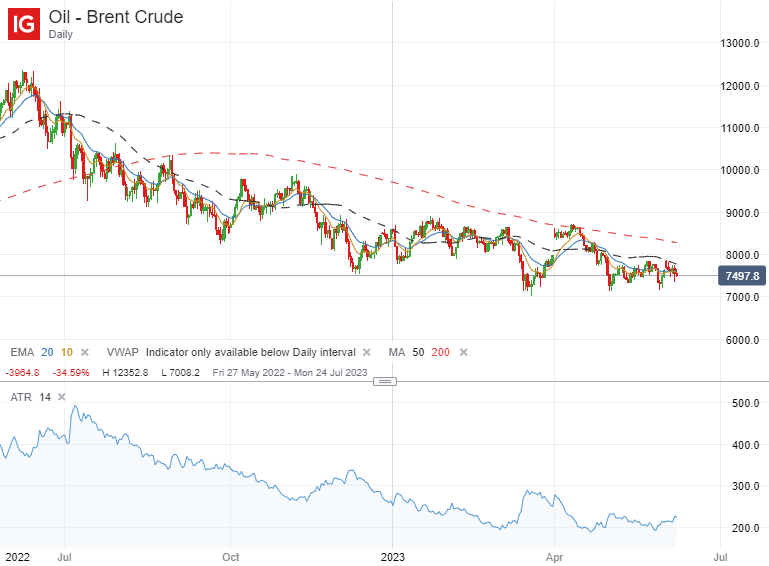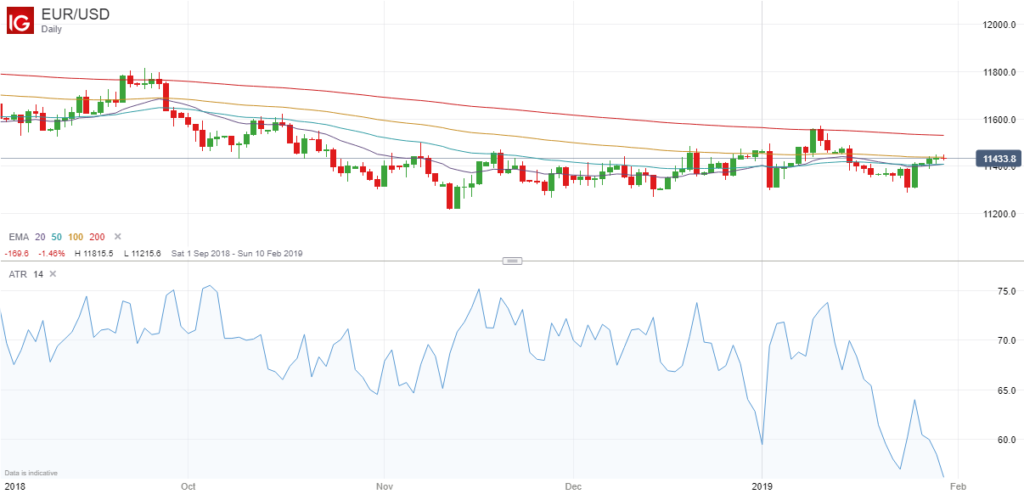Introduction
If you are day trading the forex markets, or like to trade commodities, cryptocurrencies or stock market indexes, for example, it is always useful to know which markets are showing high levels of volatility and trading in a wide range on a daily basis.
That’s because a market that is moving in a range of 200 pips per day will be a lot easier to capture decent sized profits from than a market that is only moving around 20 pips per day on average, for instance, particularly when you factor in spreads and commissions.
So with that in mind, let’s take a look at the latest average true range (ATR) readings of all of the major currency pairs, indices, commodities, metals and cryptos as of right now (11 June 2023) as we head into the quieter summer period.
This will tell you which markets are potentially worth day trading, and which ones are probably best avoided.
Major Currency Pairs
- AUD/NZD – 57
- AUD/USD – 58
- EUR/CHF – 40
- EUR/GBP – 37
- EUR/JPY – 94
- EUR/USD – 51
- GBP/EUR – 49
- GBP/JPY – 118
- GBP/USD – 81
- USD/CAD – 65
- USD/CHF – 61
- USD/JPY – 90
There is no doubt that the average true range of these forex pairs has fallen since I last compiled this data back in 2020, but that’s to be expected because that was a very volatile period as COVID was just starting to take hold all over the world.
The reality is that there are plenty of currency pairs that still offer a good deal of price movement every day, and are therefore potential trade candidates.
I myself like to mainly trade the GBP/JPY and GBP/USD pairs because they have a wide daily trading range, 118 and 81 pips respectively, as shown here, and I’m also predominantly based in the UK, which means I can trade the busy London and New York sessions.
I also used to like to trade the EUR/USD pair but this seems to move less than before, just 51 pips, and I find that the GBP pairs give me more than enough opportunities every week.
For those traders based in Asia, the major Yen pairs all provide lots of liquidity and volatility, and benefit from tight spreads, while traders based in Australia or New Zealand may also prefer to trade these pairs because of the favorable time zone and the fact that these are more volatile than the Australian and New Zealand dollar pairs.
USA-based traders are lucky because many of the USD pairs offer big price swings every day, especially the GBP/USD and USD/JPY pairs, but many of the currency pairs are very active during the US session, so most of the major pairs can potentially be traded profitably at this time.
Stock Market Indices
- FTSE 100 – 58
- DAX – 123
- DOW JONES – 269
- S&P 500 – 40
- NASDAQ 100 – 195
With the S&P 500 hanging out in the 4050-4150 range for several weeks and seeming reluctant to fall back down, the volatility of this index fell sharply, and now has a daily average price movement of just 40 points.
This has made it noticeably harder for many day traders to trade because there have been a lot of sideways price movements in recent months, which will often chop you up.
The other indices have also experienced narrower trading ranges, with the Nasdaq 100 almost half as volatile (195 points) as it was this time last year, for example.
That’s to be expected when we experience rising stock markets, but it’s not necessarily beneficial to day traders, who can often generate more profits when the markets are falling, or at least fluctuating up and down a lot more.
Commodities
- BRENT CRUDE – 225
- US CRUDE – 236
- GOLD- 23
- SILVER – 48
Gold, and to a lesser extent silver, often present day traders with plenty of volatity, and that’s still the case now. With a daily range of $23, gold still continues to trade in quite a wide range on a daily basis.
As you can see below, the oil markets have calmed down a lot since a year ago, when they were moving an average of 500 points per day, but I find that they still offer lots of good trading opportunities with a trading range in excess of 200 points per day.

Cryptocurrencies
- BITCOIN – 861
- ETHEREUM – 58
There was a time when day trading cryptos was practically impossible because of the prohibative spreads, but with a daily trading range of 861 points on Bitcoin, for example, and much tighter spreads, it is now possible to generate profits from these daily price movements.
I don’t attempt to do so myself, but I know a few people who find that their usual day trading strategies work just as well, if not better on these instruments.
Final Thoughts
It is often said that scalpers should look to capture around 10% of the daily average true range (ATR) per trade, while proficient swing traders should look to capture up to 40% of the average range.
So despite the fact that we are entering one of the quietest periods of the year when many people will be taking vacations and enjoying the summer, there is still plenty of volatility in the markets to keep day traders satisfied.
I like to focus my attention on the GBP/JPY and GBP/USD pairs, as well as gold and US crude oil, but with average trading ranges of 195 and 269 points on the Nasdaq and DJ30 respectively, it’s easy to see why some traders focus on the indices instead.
Ultimately it comes down to your own personal trading strategy and what works for you, but finding the markets with the highest volatility will often help you in your quest to generate consistent returns.
